
Welcome to all of the new subscribers!
This is the “When I get a round tooit” Creation/Evolution newsletter from Ian Juby and CORE Ottawa
In this newsletter:
1) Random stuff I didn’t know where else to put
2) New Video: Beneficial mutations & information
3) Cretaceous Hammer Time! (The London artifact, a fossil hammer)
4) Vacation Bible School
************************************************************
1) Random stuff I didn’t know where else to put
It’s been a wild time. Please pray for me, as the Lord kindly gifted me in many ways….but organization was not one of them! Here are some random updates on various projects I’m working on:
“Persuaded by the evidence”
For a variety of reasons, this movie is now about five months behind schedule, but lots of progress has been made in the past couple of weeks. I had to re-shoot the opener 11 times already. It really should be re-shot again, but I’m not going to, I’ll work with what I have. I hope to have the video released within the month, please pray for the project.
Portable Creation Museum`
With the sponsorship from Zign Creations (who just had their software featured for the fourth time in 3D world magazine!), I was able to purchase all the steel and almost all of the hydraulics needed for the lift legs. The legs will look like what is seen below. Construction of the prototype leg has started, but was put to the side while I try desperately to get “Persuaded by the evidence” finished. The steel turned out to be attrociously more expensive than I’d originally planned, but I’m very happy with the design.
The legs extend hydraulically, lifting the container off the ground as shown. The truck drives underneath, container is lowered onto the truck and hauled off to the next destination.
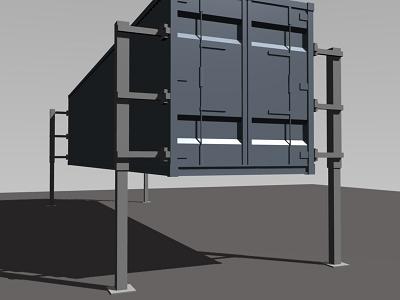

CrEvo Rant #110: “Natural selection gets pwned”
Working on several rants at the present, but this is my favourite. Hope to have it done soon, but am awaiting artwork. The premise dealt with is the erroneous claim that natural selection is the “guiding force” behind evolution. So of course, with a subject like natural selection – laughs abound. I’ve been hacking at it on the side, with “Persuaded” being the primary job right now.
Scene right is the two scientists in the labs of Cold Fusion Solutions. Hint: They get pwned. 🙂
The Flood movie
As y’all know, I’ve a part of the technical review team for a Hollywood production on Noah’s Flood. We, the technical review team, have been debating the science behind the film and its premise for over a year now, and we’re just finishing up those deliberations. The last round alone had about 250 pages of reading, so it’s a lot of work. Please pray for all of us as the producers figure out what the next steps in the process will be. The results of the technical review panel will be published in an e-book later on this year.
Rock Solid Answers
As some of you will recall, I had the privilege of authoring a chapter in the book “Rock Solid Answers: The Biblical Truth Behind 14 Geological Questions,” edited by Mike Oard and John Reed. This is a fantastic book I’d highly recommend. And no, I do not get a single penny from the sale of that book, it’s just  an excellent book. Mike and John wanted to put together a book answering the common claims of old-earth, anti-creation advocates. Rock Solid Answers was the result. Geared for the layman, it is technical (it needs to be) but readable.
an excellent book. Mike and John wanted to put together a book answering the common claims of old-earth, anti-creation advocates. Rock Solid Answers was the result. Geared for the layman, it is technical (it needs to be) but readable.
The chapter I wrote was on the polystrate fossils of Joggins, Nova Scotia. These fossils have been used since the beginning of the old-earth movement to convince people that the earth is millions of years old. In actual fact, the fossil cliffs provide powerful evidence for Noah’s flood, and refute the ideas of deep time. This chapter, Chapter 13, is now available on line for free reading here:
https://ianjuby.org/rock_solid_13.html
E-newsletter
If you’re reading this, then it must mean I managed to get a newsletter finished and sent off. 🙂
************************************************************
2) New Video: Beneficial mutations & information
 I have NO idea why – but it seems the past couple of months, I have been inundated with questions about mutations, information in the genetic code, etc… That subject seems to be the rage lately.
I have NO idea why – but it seems the past couple of months, I have been inundated with questions about mutations, information in the genetic code, etc… That subject seems to be the rage lately.
I got an email from one skeptic, pointing to a video on youtube by user “AronRa” entitled the “8th Foundational Falsehood of Creationism: Mutations are rare, harmful decreases in genetic information.”
It turns out that AronRa has been posting the claims he made in this video allll over the internet, and his video was quite a big hit on youtube. His video was an impressive sounding string of anti-creation, pro-evolution arguments, but was actually a compilation of glaring errors! So I put together a video response. Within three days of posting the video, it had garnered over 300 comments, 2,000 views, and youtube emailing me suggesting I apply for the affiliate program!
In typical response, the atheists systematically ganged up on my video to vote it down and leave nasty comments….not realizing that in so doing, they actually promote the video. <big ‘ol grin>
So considering that thousands of people are trying to suppress my video, I’d like to ask y’all a favour: Share the video and/or the script with as many people as you can. Link the video on Christian discussion forums (seeing as how the atheists have done just that with AronRa’s video), and especially if you can – rate the video, as the atheists have ganged up to deliberately rate it down so others will be less inclined to watch it. If you feel up to it, rant in the comments section. You’ll probably just get a bunch of angry, profane responses to your comment, but I just ignore those. 🙂
You can view the video on youtube:
And the entire script for the video is right here:
https://ianjuby.org/newsletter/?p=421
It turned out to be an excellent opportunity to not just answer the skeptics, but also make numerous talking points about creation, evolution and genetics.
************************************************************
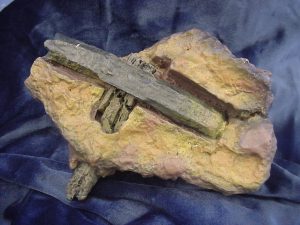 3) Cretaceous Hammer Time! (The London artifact, a fossil hammer)
3) Cretaceous Hammer Time! (The London artifact, a fossil hammer)
By request, I thought I would take the time to detail the “London artifact” – a fossil hammer which most will have seen my cast on display in my traveling museum. Unfortunately, nothing formal has been written on it as of yet. David Lines and I (both research associates with the Creation Evidence Museum, who owns the hammer) are working to remedy that. Because there are a couple of other articles in queue for writing before the hammer article, and because people had been requesting details, I thought I would give a brief (emphasis on brief) layman’s web write-up, spelling out the case for the fossil hammer from the “dinosaur era.”
The Find and Location:
In June of 1936, Max Hahn was fishing with his wife, Emma, at a waterfall near London, Texas. He found a rock sitting on a ledge with a piece of wood sticking out of it. Naturally interested, he took the rock home where several years later the family broke open the rock to discover that the wood was actually the handle of a hammer! Due to privacy concerns of the land owners, the actual location of the find is secret.
To verify if the hammer head was metal or not, a file was used to cut into the steel. That cut is shiny and unrusted, many decades later.
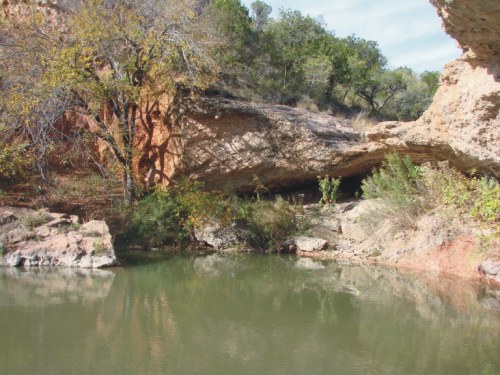
The discovery site of the “London artifact”
In 1983 the hammer was purchased by the Creation Evidence Museum. By this time, because the hammer had garnered so much attention over the years, with people literally driving great distances to see it, much of the encasing rock had been chipped off and given as souvenirs to various individuals. Fortunately, there remains enough of the encasing rock to make numerous observations, and positive identification of the source rock layer.
The rocks in the general area of the discovery site are classified as “Ordovician” on the evolutionary timescale – allegedly 450 million years old, but contact the “Cretaceous” layer called the Hensell Sands (allegedly 110 million years old). This transition from Ordovician to Cretaceous in the immediate area is probably what led to the initial confusion over the exact evolutionary dating (as if it can be exact!), as letters and phone calls to geologists initially labeled the location as Ordovician.
The rocks at the waterfalls are a conglomerate – rounded gravels that have been re-cemented back into other rock layers.
For reasons to be discussed, we have concluded that the hammer actually came from a rock layer many miles upstream in the Cretaceous Hensell sands – which according to evolution, dates to the time of the dinosaurs. In either case, an obviously man-made artifact should not be in such “old” rock, according to evolutionary dogma. In fact, as Louis Jacobs (former president of the society for vertebrate paleontology) put it, man and dinosaur living at the same time would prove that evolution is wrong, that the earth is young, and that the Biblical account of Creation could certainly be correct.
There were two silver mines in the immediate area of the falls, run in the late 1800’s through the early 1900’s by a Spanish mining company. One at the falls, and one several miles downstream.
The Hammer Handle:
The hammer handle itself is primarily still wood, with portions fossilized, and other portions turned to coal. Some skeptics of course might jump on this, claiming that wood that has not fossilized proves the hammer is recent. However, having all three states of wood (petrified, woody and coalified) in “Cretaceous” formations is surprisingly common. I have personally seen preserved wood in lower Jurassic layers in Northwestern Colorado (The Morrison formation), and the late cretaceous of Alberta (Horseshoe Canyon formation). One log from the Northern Colorado dinosaur dig site is on display at the entrance to Creation Evidence museum, which also shows all three preserved states. So the wood in the handle neither verifies nor refutes its age, but the coal and the permineralization would certainly seem to lend credence to a greater age.
The shape and purpose of the hammer:
The skeptics have argued that it’s simply a modern hammer. A modern hammer that was dropped in Cretaceous or Ordivician sediments and fossils, which were then basically glued (cemented) together to form a rock surrounding the modern hammer, making what is called a concretion. Certainly one should address this concern, seeing as how the hammer and rock were not found in-situ (in the rock layer it came from).
Now we do need to bear in mind that a hammer is a hammer. You’re only going to have so many variations of a hammer head, so finding a modern hammer that looks like the London hammer doesn’t necessarily prove that the London hammer is modern. For example, a pre-flood culture may have produced a hammer identical to our modern hammers. There is no reason to doubt this. But the London hammer does indeed have a very unusual head. Four points and a concave on one end, and a “button” on the other – which was presumably the mount for a soft cover of some kind, like a mallet. Some have suggested it was perhaps for fine metal work (i.e., gold leafing, coppersmithing, etc…), which seems quite reasonable, based on the size, weight and shape of the hammer head.
Nevertheless, the claims of the skeptics regarding the London hammer have been an outright fiasco.
Multiple skeptics have claimed to have found an antique hammer which matches the London hammer. But when one starts to enquire, you find out very quickly that the skeptics contradict themselves, and each other, and when asked to back up their claims, not one of them ever comes up with the antique hammer they claimed looks just like the London hammer!
For example:
- The NCSE claims it’s a 19th century miner’s hammer, and it was “of recent American historical style” (but doesn’t provide an example of said recent American style hammer)
- Wikipedia says it’s an 18th century miner’s hammer in “million year old Ordovician rock” (ignoring the glaring error, so typical of Wikipedia, on the alleged age of the Ordovician, the edtiors of Wikipedia make a claim but do not provide an example of an alleged miner’s hammer that looks like the London hammer)
- Dr. Stephen Meyers (not to be confused with the ID proponent) claimed it was a 19th century miner’s hammer and a wagon wheel rim hammer! (So… which is it?)
There is no hammer “of recent American style” that looks even remotely like the London hammer. The London hammer would be a completely and utterly useless miner’s hammer, nor do any miner’s hammers of any era even remotely resemble the London hammer. The London hammer would be even more useless for a wagon wheel rim hammer, nor does it even look like a wagon wheel rim hammer! You can see this for yourself – just do a Google image search. In fact, here, let me help you out a little bit:
Antique miner’s hammers:
http://www.rideau-info.com/canal/tales/images/drill-tools-plousos-web.gif
http://www.goantiques.com/detail,mineral-hammer-miner,660748.html
Spanish silversmith’s hammers:
http://www.history.org/Foundation/journal/Winter08/images/Pix03_r1.jpg
http://wpcontent.answcdn.com/wikipedia/commons/thumb/7/71/Silversmithing_anvils_and_hammers.jpg/240px-Silversmithing_anvils_and_hammers.jpg
Blacksmith’s hammers:
http://www.collectibles-articles.com/antique/14-Old-Used-Blacksmith-Hammer-Heads-Cut-Devil-B-O-RR_190473115891.html
Random hammers:
http://farm3.static.flickr.com/2678/4454946558_62547ec745_z.jpg?zz=1
Wagon Wheel Rim Hammer:
http://www.scienceattractions.com/images/products/hammer_2.jpg
As a matter of fact, Vance Nelson, curator of Canada’s largest traveling creation museum, wrote to Dr. Meyers back in 2004:
“Hello, I came across your website today. You mention about a dozen hammers like the “London” hammer claimed by Carl Baugh to be “Pre-flood” have been found in Scott’s Bluff Nebraska. Would it be possible to get a photo of these hammers? This fact would seem to be a serious blow to Baugh’s assertions. Thanks in advance for your help.
Sincerely yours,
Mr. Nelson”
Dr. Meyers wrote back:
“Hello! Dr. Murray can’t remember any other information about these hammers. I don’t think he has any pictures of the hammers. He is now 93 years old.”
Sincerely,
Stephen Myers”
Dr. Meyers has since posted an interview with Dr. Murray on youtube. Dr. Murray claimed he had a hammer that looked identical to the London hammer which was used to bend the steel rims on wagon wheels.
So please notice: we’ve gone from “a dozen hammers” like the London hammer, to one hammer, of which neither Dr. Murray, nor Dr. Meyers produced even a photo! In fact, if you listen to the interview while staring at a picture of the London hammer, it becomes immediately obvious that Dr. Murray has apparently never seen the London hammer. Because his description of the wagon wheel rim hammer (though accurate for a wagon wheel rim hammer) does not even remotely resemble that of the London hammer.
The London hammer does not have a chiseled end, nor does it have a flat end. The wagon wheel rim hammer head weighs about 4 pounds, whereas the London hammer is very small – the head weighs only one pound!
Creationist Hugh Miller spent some six months searching for a matching hammer in multiple museums while he was on the road as part of his job. He was unable to find even a close match, anywhere. I myself have looked at photos of hundreds (thousands?) of antique hammers, and have yet to find one vaguely resembling the London hammer.
Surely if the London hammer was of recent origin, someone, somewhere would have come up with a match to it?
Cave formations:
Further to that, Dr. Murray’s discussion about fast rock formations and calcite deposits in caves have absolutely nothing to do with the London hammer! Dr. Baugh, David Lines, and especially Vance Nelson and myself, are well aware of rapid rock formations and calcite accumulations. Calcite accumulation and growth rates have been a special study project of both Vance and I. The London artifact was not encased in a calcite deposit, because in calcite deposits one sees layers of calcite growth. Such layers are absent from the sandstone (not calcite) surrounding the London hammer. There are no cave/calcite formations (i.e., stalactites, stalagmites) anywhere near the London hammer discovery site, nor was the hammer found in a cave, nor are there any hot springs anywhere near the area.
It amazes me that Dr. Murray waxes on for a very long time, thinking he’s making us creationists look like fools – discussing things that have nothing to do with the London hammer. All the while he provides case after case of rapid accumulation of calcite in caves. Do you think he would then concede that cave formations (like stalactites and stalagmites which grow in caves) do not take millions of years to form? Do you think Dr. Meyers would agree as well? The contradictions become rapidly evident in the old earth arguments.
Concretions:
It is true that concretions happen all the time. In fact, I am going to refer to the rock encasing the hammer as a concretion, but note that concretions are also found in rock layers. I will show the case that the concretion formed around the hammer with the source rock layers which also hardened up – rock layers I would contend were formed during Noah’s flood.
The kind folks over at the Lost World Museum loaned one such example of a recent concretion to Dr. Baugh and I for the production of a television show: a Champion spark plug which produced a concretion of rocks, sand and shells.
There are plenty of examples like this out there, just walk the ocean beaches. Let’s examine this typical example of a concretion, and make several observations which will become pertinent in just a moment.
Notice:
- the excess of gravel/rocks in the concretion
- the shell is badly, and obviously, abraded
- the rust was obviously the trigger for the growth of the concretion
- the metal is in direct, cementing contact with the concretion
- the rust was the main cementing ingredient
- the iron is badly corroded – almost disintegrated. Large amounts of the iron was consumed in the cementing process.
Now let’s examine the rock surrounding the London artifact.
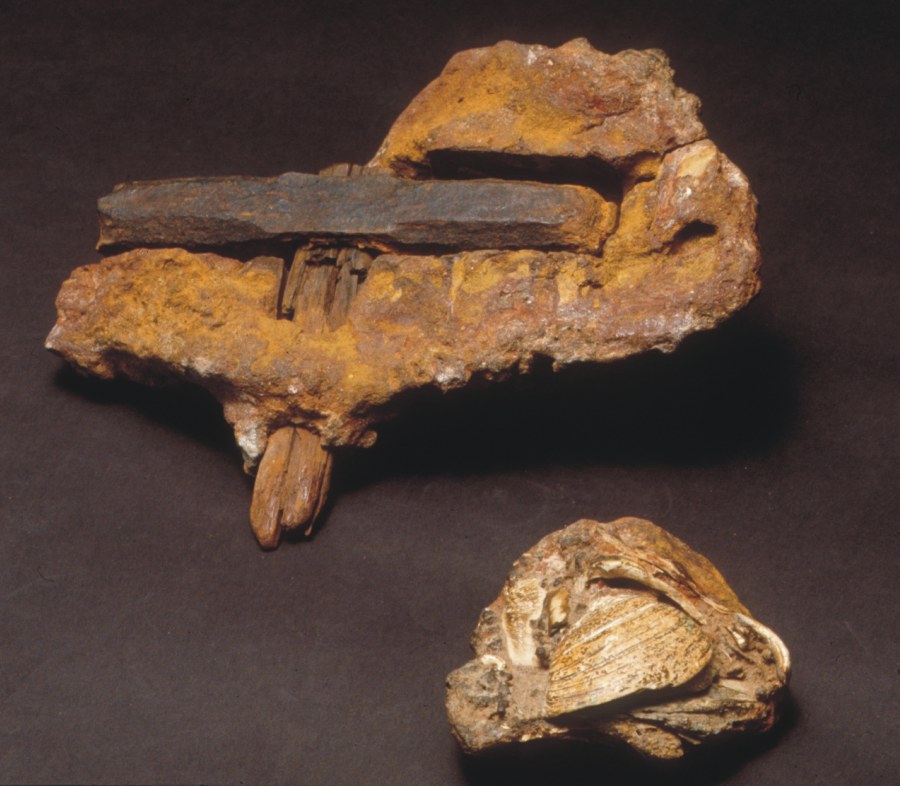
Photo courtesy of David Lines and Creation Evidence Museum.
The rock in the bottom right corner is the remaining chunk of rock matrix that was surrounding the hammer.
There are several noteworthy things when comparing the London artifact to a recent concretion:
- the matrix is primarily sand, not gravel
- there is an unusual gap surrounding the hammer head – the iron is not in direct contact with the surrounding rock (typically a gap averaging .17″)
- the iron is not cemented to the surrounding rock
- the iron may have played a role in either triggering, or hardening the cementation, but as we already mentioned, this iron is extremely resistant to rust, and so there was not enough iron consumed to cause cementation
- the pelecypod shells in the rock show no more abrasion or breakage than the fossil shells in the source rock, five miles upstream from the discovery site
- the iron head shows remarkably little corrosion (compared to the spark plug for example) and is well preserved
The hammer encased in stone most resembles that of a fossil encased in stone, not a concretion. In this case, the fossil was a hammer which leached iron into the surrounding rock ,strengthening an area surrounding the hammer. Thus, when the rock was eroded out of the cliff, this clump of rock was more strong than the rest of the rock, and helf together better during transport down river.
If this were a recent concretion, there should be plenty of gravels in the concretion, as gravels make up the majority of the river bed. It is for this same reason that recent concretions (like the Champion spark plug) have so much gravel in the concretion: the area they form in has plenty of gravel.
The shells in the rock matrix are pelecypods, common to some cretaceous formations, and are a key to figuring out whether or not the rock matrix was a modern concretion, or a chunk of rock containing a fossil hammer which eroded out of cretaceous layers and was washed downstream.
The Fossil Shells:
David Lines and the late geologist John Watson, surveyed the area of the hammer find in 1992 and 1994. I also visited the area in 2008. Lines and Watson had full permission from local land owners to pursue investigation wherever they wished to go. Investigating the immediate site of the find (the waterfalls), Lines and Watson found one pelecypod shell embedded in a loose rock above the falls. They did find a very few pelecypod shell fragments in the river bed, quite a bit upstream from the falls, and the shells had obviously been badly abraded. The reason for this becomes obvious: There were no pelecypod shells in any of the rock layers in the immediate area of the falls. The nearest place you could find such shells was several miles upstream from the falls, in the Cretaceous rock layers known as the Hensell Sands. The shells in this layer are as numerous, and as well preserved as those found in the hammer rock matrix. The composition of the rock layer itself also matches the composition of the rock surrounding the hammer. So it is evident that the hammer came from this area, which is several miles upstream from the falls, and the silver mines.

John Watson at the layer identified to be the source rock of the London hammer fossil.
Photo courtesy David Lines
While shells can and do erode out of this cliff, the shells are quickly abraded and destroyed by erosion, unless they are encased in a rock matrix. The rock “backs up” the fossils and protects from further breakage and erosion. It should be noted that many of the fossil shells in the Cretaceous rock layer are already broken, just like what is seen in the hammer rock matrix – this is common with fossil shells in the rock record.
Once fossil shells are worked loose from the host rock, the shells are rapidly abraded – not just the edges, but the patterns on the shells as well. John Watson actually compiled a research report on these rapid abrasion rates in TJ, back in 1994 (“An investigation of the reworking of ammonite fossils,” John A. Watson, Creation ex nihilo Technical Journal, Volume 8, Issue 1, April 1994, pg 78-84). The only abrasion & breakage of the shells in the rock matrix is that which matches the fossil shells in the source Cretaceous rocks, or what would be expected had the entire, intact concretion rolled downstream a few miles.
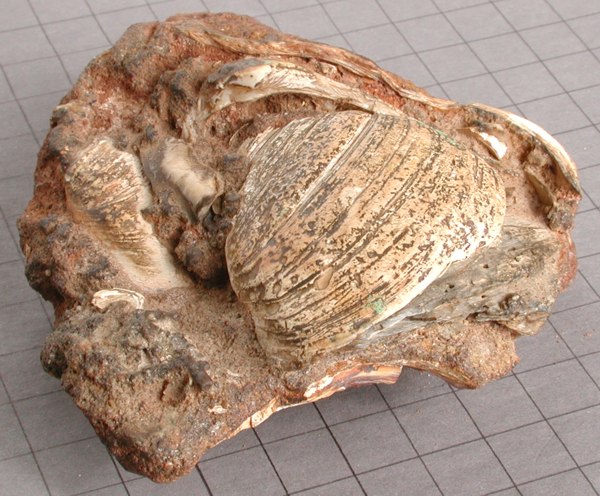
London artifact rock matrix with numerous pelecypod shells.
Photo courtesy David Lines
But let’s put another nail in the coffin of the “modern concretion” argument: There are, essentially, no shells in the riverbed that are available for cementation into a concretion! While I was limited in what areas I could study, I was still able to survey the riverbed for large areas. I did not find a single fossil shell. Not a one! Lines and Watson found one fossil shell above the falls, encased in rock, and a few badly abraded shells miles upstream from the falls (only near the source Cretaceous rocks). It would be fair to say that Lines and Watson found about ten shells over some 5 miles of river bed.
Bearing in mind that we no longer have all of the rock matrix that was surrounding the hammer (and thus it’s likely there were more shells in the concretion), you’ll notice that in the rock matrix we have left, there’s around ten fossil shells. The total volume of the rock matrix (including the hammer volume) is probably on the order of 130 cubic inches. So to believe the “modern concretion” theory, we are expected to believe that the hammer somehow found and cemented ten fossil shells to itself, when the most generous estimates are that you’ll only find that many fossil shells spread out over some five miles! I say “generous estimates” because I personally did not find a single shell, therefore by my survey there were zero shells available for cementation. Furthermore, this cementation somehow did not cement any of the abundant gravels from the riverbed.
So the shells in the rock matrix surrounding the hammer show no evidence of being re-worked. The lack of gravels in the concretion matches the Cretaceous source rock, but not the riverbed. The fossil shells and composition of the rock match the Cretaceous layers upstream from the falls, and the quantity of shells per rock volume also matches the host Cretaceous rock layers, but is in stark contrast to the riverbed and waterfall area. In each of these specific ways, the rock matrix does not match the area surrounding the falls or the silver mines, nor the river bed but does exactly match what we would contend is the source rock: The Cretaceous Hensell sandstone layers.
The Metal of the Hammer Head:
The composition of the hammer head is also fascinating. It is highly resistant to corrosion, presumably because of the high silica content in the iron, revealed by sampling of the metal and compositional analysis. Chlorine is also compounded in the surface of the steel, possibly from the quenching process. The quenching process is used to harden steel to make it useable. The iron is heated up red-hot, and then dropped in water (in this case, probably salt water, or water doped with an agent containing chlorine). The rapid cooling causes the surface of the steel to become hardened.
The extreme resistance to corrosion is evident from the file cut made several decades ago which has not rusted even in the Texas humidity. Humidity in this area causes corrosion problems on non-painted surfaces like the rusting of antique piano strings for example.
Conclusions:
- There is no evidence that the rock matrix surrounding the hammer is a recent concretion.
- There is no evidence that the shells in the rock matrix have been reworked, which would indicate a recent concretion.
- There are no unabraded shells available in the riverbed for the rock matrix to be a recent concretion.
- The composition of the rock matrix and the embedded fossil shells match the Cretaceous Hensell Sandstone layer, which for multiple geological reasons we would contend was laid down during a world wide flood.
- Contrary to the rather silly suggestions of some skeptics, the rock matrix did not come from a calcite growth, nor is there any calcite formations or hot springs in the area.
- In spite of the fact that there should only be so much variation in hammer head styles, neither skeptics nor creationists have been able to produce a single historic hammer like the London hammer. Upon further examination, the claims of the skeptics have turned out to be either baseless, or venturing into the ridiculous, putting another nail in the coffin of the “modern hammer” claim.
We therefore conclude that the London artifact is good evidence of man at the time of the dinosaurs, and a good example of a genuine antidiluvian (pre-flood) artifact.
************************************************************

4) Lectures & Vacation Bible School
Still seeking bookings within a 10 hour drive of Chalk River, Ontario. Would your church or group want the museum and a lecture? Give me a call toll-free at 877-532-9160, or drop me a line at ianjuby at ianjuby.org
Remember – Everything you ever wanted to know about booking Ian Juby but were afraid to ask:
https://ianjuby.org/promotional.html
Vacation Bible Schools!
And Yup – I’m also doing Vacation Bible Schools this summer! Last year was my first trial run, doing a couple of VBS’s, and they were hugely successful, and a whole pile of fun.
So for those who are planning on VBS’s this summer, consider having a dinosaur & creation VBS! I’ll bring the whole museum, give a half-day program for five days – complete with crafts! Just think: Not only do the children learn the Bible, they learn science as well.
Read all about it here:
https://ianjuby.org/vbs.html
************************************************************
These newsletters typically take about 20 to 40 hours worth of work, and I insist on keeping it free. I have had many people ask me to include info on how to donate towards this ministry. If you don’t need/want a tax receipt, you can donate online here, or you can support this ministry and get a tax-deductable receipt by mailing a donation (checks made out to CORE Ottawa) to CORE Ottawa, Kanata North Post Office Box 72075, Ottawa, ON. Canada, K2K 2P4 And thank you to those who support both prayerfully and financially.
Subscribing and Unsubscribing:
If you received this email from a friend, and would like to subscribe yourself, click here and enter your email address into the “CSMC” subscribe box. May I also suggest you sign up for the free “In 7 Days” crash course in creation.
If you are forwarding this email to friends, I’d suggest you strip off the unsubscribe link at the bottom here – otherwise someone else will unsubscribe YOU. And thank you for sharing this newsletter! It always pleases me to hear that a reader finds my humble writings worthy to be passed on to a friend of theirs.

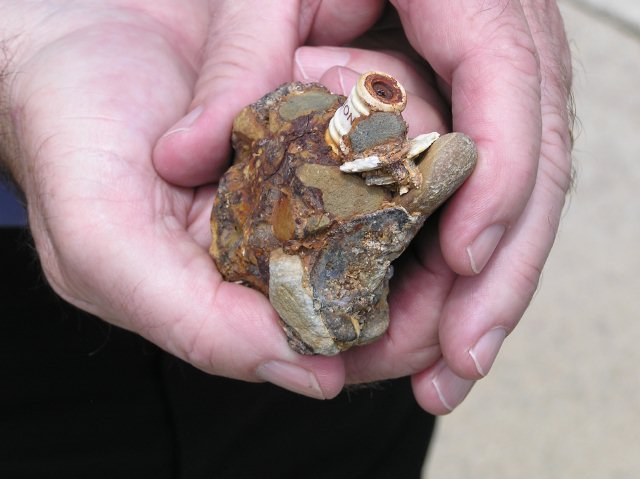
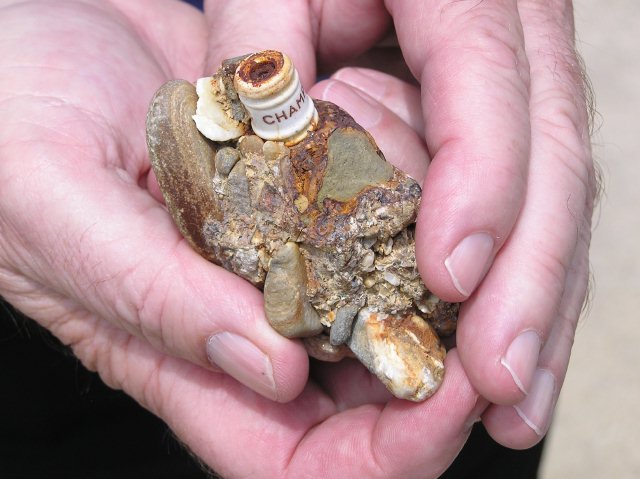





I just wanted to write to you to thank you for being the only one that I know of who has compared these things on the hammer in rock to the other concretion example. I was recently on Twitter, going back and forth with atheists on how “millions of years” + evolutionary mythology is silly and bogus, and one of the examples I used was the hammer in rock to prove the point (among many others). One of them brought up “concretion” and I could not do any comparison of my own because I’m not an expert but, I did a search and found YOU comparing these things here! Great job! Thanks again!
Until Jesus returns for His church! See you in the sky soon! 🙂